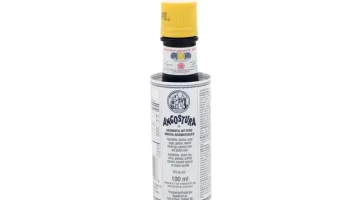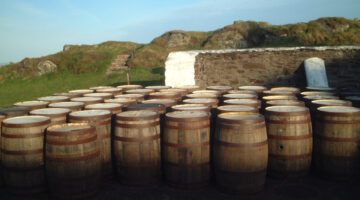What is Arak?
Travel Distilled explains what Arak is, the history of this Middle Eastern spirit, how and where it’s made, how to drink it and use it in cocktails and cooking.
Arak, a traditional Middle Eastern spirit, has gained popularity worldwide in recent years. This post aims to provide a comprehensive overview of arak, including its history, production process, cultural significance, drinking etiquette, and its versatile use in both cocktails and cooking.

What is Arak’s History?
Arak has a rich history that dates back centuries. It has been enjoyed in the Middle East for generations and holds deep cultural significance. The origins of arak can be traced back to the ancient civilizations of Mesopotamia and Persia (now Iran). Over time, arak spread throughout the region and became an integral part of Middle Eastern culture, often associated with celebrations and social gatherings.
How is Arak Made?
The production of arak is a passionate art form, requiring both skill and patience. Its principle base ingredient is white grapes, usually the native Obeidi variety, although other types of quality white grapes can also be used.
Grape Fermentation: The arak production process begins in the vineyard, where the grapes are carefully chosen and harvested when sufficiently ripe. After harvesting, the grapes are promptly crushed to obtain the fresh juice, also known as must. This must is then transferred into large fermentation vats, often made of clay or copper. Fermentation occurs naturally, as the sugar in the grapes transforms into alcohol. This process typically takes one to three weeks, depending on the sugar content of the grapes and the ambient temperature.
First Distillation: Once fermented, the liquid, now a type of wine, is distilled. Distillation is a heat-based process that concentrates the alcohol and separates it from the other substances present in the wine. The first distillation aims to produce a raw spirit known as ‘low wine,’ which contains about 30-40% alcohol.
Anise Addition & Second Distillation: The second distillation involves adding anise, a spice that gives arak its signature taste. The anise is soaked in the low wine for several hours before the mixture is distilled again. The aniseed’s essential oils rise with the alcohol vapors, creating a fusion of flavors, which condense and eventually collect into a separate container. After the second distillation, the arak reaches an alcohol content of about 70%.
Third Distillation: Some producers pursue an optional third distillation, which further purifies the arak and ingrains the rich anise flavor.
Ageing: After distillation, the arak is left to rest or mature in clay amphoras for one to three years. This ageing process helps the flavors develop and gives the arak a smoother, mellow character. Modern techniques might store it in stainless steel vats to prevent it from acquiring any external flavors.
Where is Arak Made?
Arak is produced in various countries across the Middle East, each with its own unique twist. These include Lebanon, Syria, and Israel, and there are distinct characteristics of the arak from each region. Lebanese arak, for example, is known for its smoothness and anise-forward flavor profile, while Syrian arak is often aged in clay jars, giving it a distinct earthy taste.
What is Arak’s Cultural Significance?
In many Middle Eastern countries, arak is often enjoyed during festive occasions, weddings, and family gatherings, where it serves as a symbol of togetherness and celebration.
How to Drink Arak
Drinking arak is more than just sipping a spirit; it involves a unique set of rituals and etiquettes. Arak is typically served in a special glass called a “rakweh” or “arak glass,” which has a long, thin neck and a wide base. It is traditionally consumed by diluting it with water and adding ice cubes, which helps to release the flavors and aromas.
Arak in Cocktails
Arak’s distinct anise flavor makes it a perfect base for cocktails. From the classic Arak Mojito to innovative creations like the Arak Sour or Arak Martini, there are endless possibilities to explore when it comes to mixing arak into delicious cocktails.
Arak Cocktail Recipe
The Exotic Arak Mojito
Ingredients:
2 oz of arak
1 oz of fresh lime juice
1 oz of simple syrup
6-8 fresh mint leaves
Soda water
Ice cubes
Instructions:
In a cocktail shaker, muddle the mint leaves with lime juice and simple syrup.
Add arak and a handful of ice cubes to the shaker.
Shake vigorously for about 15 seconds to combine the flavors.
Fill a glass with ice cubes and strain the cocktail into the glass.
Top off with soda water and garnish with a sprig of fresh mint.
Stir gently and enjoy the refreshing and exotic flavors of the Arak Mojito.
Arak Cocktail Recipe
The Exotic Arak Mojito
Ingredients:
2 oz of arak
1 oz of fresh lime juice
1 oz of simple syrup
6-8 fresh mint leaves
Soda water
Ice cubes
Instructions:
In a cocktail shaker, muddle the mint leaves with lime juice and simple syrup.
Add arak and a handful of ice cubes to the shaker.
Shake vigorously for about 15 seconds to combine the flavors.
Fill a glass with ice cubes and strain the cocktail into the glass.
Top off with soda water and garnish with a sprig of fresh mint.
Stir gently and enjoy the refreshing and exotic flavors of the Arak Mojito.
Arak in the Kitchen
Arak is not limited to the glass; it also adds depth and complexity to many culinary creations, including marinades, sauces, and desserts. Arak can be used to enhance the flavors of grilled meats, seafood, and desserts like baklava. Its unique anise notes add a delightful twist to various recipes, making it a versatile ingredient in the kitchen.
Conclusion
Arak, with its rich history, unique production process, and cultural significance, is a spirit that deserves attention. Whether enjoyed neat, in cocktails, or as a flavor enhancer in cooking, arak offers a taste of Middle Eastern tradition and a glimpse into a complex and diverse culture.











